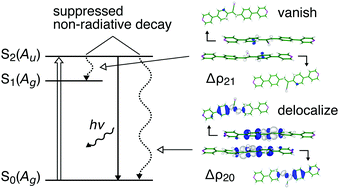Origin of aggregation-induced enhanced emission: role of pseudo-degenerate electronic states of excimers formed in aggregation phases†
Abstract
The origin of aggregation-induced enhanced emission (AIEE) is investigated considering cyano-substituted 1,2-bis(pyridylphenyl)ethene (CNPPE) as an example. On the basis of ONIOM calculations using time-dependent density functional theory (TD-DFT), we found that pseudo-degeneracy of excimers formed in solid phase plays an important role in the appearance of AIEE. The electron density difference delocalized over molecules gives rise to small diagonal vibronic coupling constants (VCCs), which suggests that the internal conversion is more suppressed in the solid phase than in the solution phase. The reduction of the off-diagonal VCCs owing to the packing effect is elucidated by vibronic coupling density (VCD) analysis. Pseudo-degeneracy enables fluorescence from the high singlet excited states against Kasha's rule because the electron density difference and the overlap density between the excited states vanish. A Hubbard model of a pseudo-degenerate electronic system is constructed to explain the vanishing mechanism. We propose the following design principle for AIEE: a candidate molecule for AIEE should have pseudo-degenerate adiabatic electronic states in the aggregation phases originating from excimer formation.



 Please wait while we load your content...
Please wait while we load your content...